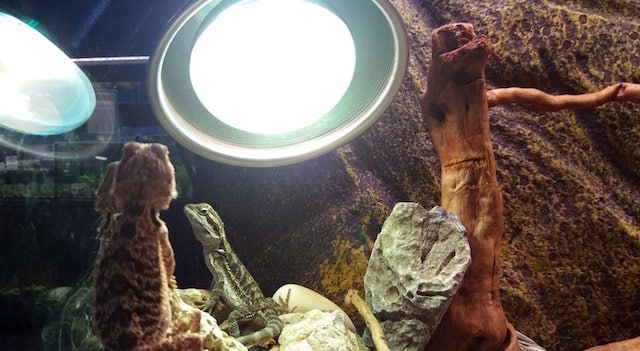
Introduction to Bearded Dragon Lighting
Proper lighting is essential for keeping a healthy bearded dragon. Without the right lights, beardies can suffer from metabolic bone disease and other health problems. This bearded dragon lighting guide will provide all the information you need to ensure your pet gets the proper light exposure and stays healthy.
In this article, we will discuss:
- UVB bulbs and which ones are best for bearded dragons
- How to position UVB bulbs correctly in your tank
- What’s the best setup for a basking lamp
- Creating a temperature gradient
- Plenty of other tips will help you create an optimal environment for your bearded dragon.
What lighting does a bearded dragon need?
When setting up your bearded dragon enclosure lighting, you will require these three essential pieces of equipment.
- Heat lamp (Basking bulb)
- T5 UVB Tube in reflector fixture
- Ceramic heat Emitter (Only if nighttime temperatures drop below 50°F/10°C)
UVB light for bearded dragons
Bearded dragons require UVB rays to produce Vitamin D3. Without it, they can’t absorb and use calcium, which can lead to metabolic bone disease, a nasty affliction that can cause growth problems and disfiguration.
The first step in setting up your bearded dragon’s habitat is to choose the right UVB lighting. We recommend a T5 UVB fluorescent tube in reflector fixture. T5s have a higher output; therefore, they can be placed further away from your bearded dragon and mounted outside the tank. A T5 can be positioned above the mesh top of your beardie’s enclosure.
T5 UVB tubes need to be replaced every 12 months.
Where to position T5 UVB tubes
It’s important to note that the UVB tube should cover half of the tank (eg. if your tank is 4ft long, you will require a 2ft long UVB tube). The middle of the UVB tube should overlap the basking heat bulb. The UVB is strongest in the middle of the tube and ensures that the UVB covers the entire basking zone.
The distance between the T5 UVB tube and the bearded dragon’s back should be no closer than 12 inches. Always check the manufacturer details to ensure that you have the right strength UVB and the correct distance for the height of your tank. UVB rays have a limited range, and in order to reach the bearded dragon, they should be placed at just the right height. If the UVB bulb is too high, the rays won’t penetrate down far enough, and your beardie won’t get the required exposure.
Investing in fixtures with reflectors is a good idea to ensure that your pet is getting the maximum amount of UVB possible! This is especially important if you have a UVB tube mounted outside the enclosure and shining through a mesh top. The mesh blocks some of the UVB rays from getting into the tank, and a reflector will help to maximize the output.
Basking light for bearded dragons
Your bearded dragon needs a basking lamp in addition to the UVB bulb. This fixture provides warmth and helps regulate the tank’s temperature.
You must position the basking lamp at one end of the tank, not in the middle. This will create a “hot side” and a “cool side,” allowing your bearded dragon to move between the two environments as needed. The resulting “temperature gradient” will let your beardie warm or cool down to regulate its body temperature.
You should also set up a basking spot directly underneath the basking lamp, raised off the floor and offering closer proximity to the lamp. A flat rock or a log makes the ideal lounge chair for your lizard to soak up the heat of their beloved basking lamp.
Bearded dragon tank temperatures
It’s essential to use a thermostat to control temperatures in the enclosure. According to data collected by Dr Jonathan Howard (Beardie Vet), ideal air temperatures should range from 72-99°F (22-37°C) with a basking surface temperature of around 107-113°F (42-45°C).
- Basking surface temperature: 107-113°F (42-45°C)
- Cool side surface temperature: 77-84°F (25-29°C)
- Air temperature gradient: 72-99°F (22-37°C)
- Nighttime temperature: 50-75°F (10-24°C)
Best basking lamps for bearded dragons
We recommend an incandescent flood globe or high-wattage halogen globe for your basking lamp. Use a thermometer gun to achieve the exact temperature for the basking surface.
Ceramic heat emitter for bearded dragons
A ceramic heat emitter is only necessary if the nighttime temperature drops below 50°F (10°C). Use a thermostat to control tank temperatures and adjust your heat sources.
How much light do bearded dragons need?
In Summer, your bearded dragon should get 14 hours of intense light daily from the combination of the UVB bulb and basking lamp. In Winter, it can gradually decrease to 8 hours per day over several weeks. The best way to achieve this is by using a timer for your lights so they are consistently turning on and off at the same time every day.
During the summer, natural sunlight should be considered when setting up a lighting schedule for your beardie’s tank. If you have windows in the room where their tank is located, adjust the lighting schedule accordingly. It’s best to match your beardie’s lighting schedule with the sun’s natural cycle.
Bearded Dragon Lighting FAQS
What lighting does a bearded dragon need?
Bearded dragons need full-spectrum UVB and UVA lighting and a basking lamp to keep the tank warm.
Should I leave my bearded dragon light on at night?
No, your bearded dragon should not have a light on at night. Like all reptiles, they need darkness to regulate their circadian rhythms and get proper rest. A consistent dark period of at least 10 hours every night is the best way to maintain your beardie’s health and happiness.
How much light do bearded dragons need?
Bearded dragons should have 14 hours of intense lighting each day —from natural or artificial sources. Using a timer for your fixtures is the best way to ensure consistent lighting.
How to keep bearded dragons warm in the winter?
If the room temperature drops below 50°F (10°F), you will need to invest in a ceramic heat emitter to keep your tank warm enough. Make sure it’s mounted up high above the tank and directed downward toward the middle of the tank.
What are UVA and UVB lights for bearded dragons?
UVA lighting is essential for your bearded dragon’s overall health and well-being, as it helps them regulate their circadian rhythms, appetite, and mood. UVB lighting is necessary to help with calcium absorption in the body. Both types of light are essential, so ensure you have both in your tank.
Conclusion
In review, here’s what we have learned about the best lighting for a bearded dragon tank:
- Bearded dragons need full-spectrum UVA and UVB lighting and a basking lamp to keep their tank warm.
- To ensure consistent light exposure, use a timer to turn the lights on for 14 hours daily. During the summer, account for natural sunlight when setting up the schedule.
- Bearded dragons require at least 10 hours of darkness every night.
- If the room temperature drops below 50°F (10°C), a ceramic heat emitter is required to warm your bearded dragon’s enclosure.
- It is critical to position your lights correctly. Higher-output bulbs should be mounted above the tank, while lower-output bulbs should be set up inside the tank, closer to the bottom of the enclosure.
Once you know the essentials, setting up your bearded dragon’s tank with the proper lighting doesn’t seem so scary. You’ll be able to provide your beardie with the right light and temperature levels it needs to stay healthy and free from disease.



